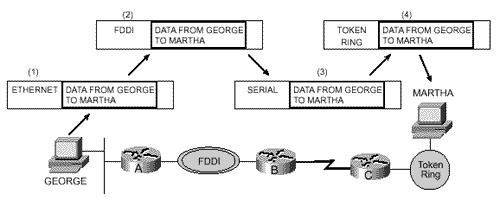Routers
| Routers have been known by several names . Back in ancient times when what is now the Internet was called the ARPANET, routers were called IMPs, for interface message processors . [8] More recently, routers were called gateways ; remnants of this nomenclature can still be found in terms such as Border Gateway Protocol (BGP) and Interior Gateway Routing Protocol (IGRP). [9] In the Open System Interconnection (OSI) world, routers are known as Intermediate Systems (IS).
All of these aliases are descriptive of some aspect of what a router does. As interface message processor implies, a router switches data messages, or packets, from one network to another. As gateway implies, a router is a gateway through which data can be sent to reach another network. And as Intermediate System implies, a router is an intermediary for the End System “to “End System delivery of internetwork data. Note Router Router , as a name , is probably the most descriptive of what the modern versions of these devices do. A router sends information along a route ”a path ”between two networks. This path may traverse a single router or many routers. Furthermore, in internetworks that have multiple paths to the same destination, modern routers use a set of procedures to determine and use the best route. Should that route become less than optimal or entirely unusable, the router selects the next -best path. The procedures used by the router to determine and select the best route and to share information about network reachability and status with other routers are referred to collectively as a routing protocol . Note Routing protocol Just as a data link may directly connect two devices, a router also creates a connection between two devices. The difference is that, as Figure 1.8 shows, whereas the communication path between two devices sharing a common data link is a physical path, the communication path provided by routers between two devices on different networks is a higher-level, logical path. Figure 1.8. A router creates a logical path between networks. Note Packet This concept is vitally important for understanding a router's function. Notice that the logical path, or route, between the devices in Figure 1.8 traverses several types of data links: an Ethernet, an FDDI ring, a serial link, and a Token Ring. As noted earlier, to be delivered on the physical path of a data link, data must be encapsulated within a frame, a sort of digital envelope. Likewise, to be delivered across the logical path of a routed internetwork, data must also be encapsulated; the digital envelope used by routers is a packet . As noted earlier, each type of data link has its own unique frame format. The internetwork route depicted in Figure 1.8 crosses several data links, but the packet remains the same from end to end. How is this possible? Figure 1.9 shows how the packet is actually delivered across the route:
Figure 1.9. The frame changes from data link to data link, but the packet remains the same across the entire logical path. The key to understanding this entire process is to notice that the frames and their related data link identifiers, which have relevance only for each individual network, change for each network the packet traverses. The packet remains the same from end to end. But how did the originating host know that the packet needed to be delivered to its default gateway for routing? And how did the routers know where to send the packet? |

